Makar Sankranti
Makara Sankranti or Maghi, is a festival day in the Hindu calendar, dedicated to the deity Surya (sun). It is observed each year in the lunar month of Magha which corresponds with the month of January as per the Gregorian calendar and is a day the people of India and Nepal celebrate their harvest.[3][4][5] It marks the first day of the sun's transit into Makara (Capricorn), marking the end of the month with the winter solstice and the start of longer days.[3][6]
| Makar Sankranti | |
|---|---|
| Also called | Magha Môkôr Sôngkrānti Mela Maghi Bhogi |
| Type | Religious & Cultural, Festival of Harvest, welcome longer days, sun worship |
| Celebrations | Kite flying, bonfires, fairs, surya puja in river, feast, arts, dance, socialization |
| Date | 14 or 15 January (Depends on Hindu Calendar Correlation) |
| 2019 date | 15 January (Mon)[1] |
| 2020 date | 15 January (Wed)[2] |
| Related to | Pongal, Maghe Sankranti, Magh Bihu, Shakrain, Maghi |
Makara Sankranti[7] is one of the few ancient Indian and Nepali festivals that has been observed according to solar cycles, while most festivals are set by the lunar cycle of the lunisolar (चंद्र – सौर) Hindu calendar.[6] Being a festival that celebrates the solar cycle, it almost always falls on the same Gregorian date every year (January 14/15),[4] except in some years when the date shifts by a day for that year.[8]
The festivities associated with Makar Sankranti are known by various names, such as Maghe Sankranti in Nepal, Magh Bihu in Assam, Maghi (preceded by Lohri) in Punjab, Haryana and Himachal Pradesh, popular amongst both the Hindus and Sikhs, Sukarat in central India, Thai Pongal in Tamil Nadu, Ghughuti in Uttarakhand or simply as 'Makara Sankranti' in Odisha, Karnataka, Maharashtra, Goa, Andhra Pradesh (also called Pedda Pandaga), Telangana, West Bengal (also called Poush Sankranti) and Uttar Pradesh (also called Khichdi Sankranti)[9][10]
Makara Sankranti is observed with social festivities such as colorful decorations, rural children going house to house, singing and asking for treats in some areas (or pocket money),[11] melas (fairs), dances, kite flying, bonfires and feasts.[10][12] The Magha Mela, according to Diana L. Eck (professor at Harvard University specializing in Indology), is mentioned in the Hindu epic Mahabharat.[13] Many observers go to sacred rivers or lakes and bathe in a ceremony of thanks to the sun.[13] Every twelve years(marking one complete revolution of Jupiter around the Sun) the Hindus observe Makar Sankranti with one of the world's largest mass pilgrimages, with an estimated 40 to 100 million people attending the event.[13][14][15] At this event, then they say a prayer to the sun and bathe at the Prayaga confluence of the River Ganga and River Yamuna at the Kumbha Mela,[13] a tradition attributed to Adi Shankaracharya.[16]
Date
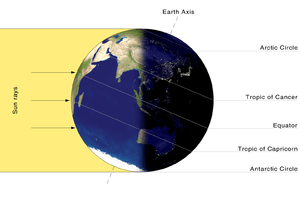
Makara Sankranti is set by the solar cycle of the Hindu lunisolar calendar, and is observed on a day which usually falls on 14 January of the Gregorian calendar, but sometimes on 15 January.[3][4][17] It signifies the arrival of longer days. Makar Sankranti falls in the Hindu calendar solar month of Makara, and the lunar month of Magha (the festival is also called Magha Sankranti or Magha festival in parts of India).[18] It marks the end of the month with winter solstice for India and Nepal and the longest night of the year, a month that is called Pausha in the lunar calendar and Dhanu in the solar calendar in the Vikrami system. The festival celebrates the first month with consistently longer days.[3]
There are two different systems to calculate the Makara Sankranti date: nirayana (without adjusting for precession of equinoxes, sidereal) and sayana (with adjustment, tropical). The January 14 date is based on the nirayana system, while the sayana system typically computes to about December 23, per most Siddhanta texts for Hindu calendars.[19][20][21] As per the solar calendar, after one year, the Sun comes to the same location 20 minutes late every year, which means the Sun needs 1 day extra after every 72 years in the sky. Because Gregorian calendar does not accommodate this difference Makar Sankranti sometimes shifts from 14 January to 15 January, and so on.
Significance
Every year Makar Sankranti is celebrated in the month of January to mark the winter solstice. It is also one of the largely celebrated Hindu festivals of India and Nepal which is celebrated differently in various cultures but the common practice on the day of Makar Sankranti is flying colourful kites.This festival is dedicated to the Hindu religious sun god Surya.[4][22] This significance of Surya is traceable to the Vedic texts, particularly the Gayatri Mantra, a sacred hymn of Hinduism found in its scripture named the Rigveda.
Makara Sankranti is regarded as important for spiritual practices and accordingly, people take a holy dip in rivers, especially Ganga, Yamuna, Godavari, Krishna and Kaveri. The bathing is believed to result in merit or absolution of past sins. They also pray to the sun and thank for their successes and prosperity.[23] A shared cultural practices found amongst Hindus of Nepal and various parts of India is making sticky, bound sweets particularly from sesame (til) and a sugar base such as jaggery (gud, gur, also Chaku in Nepali language). This type of sweet is a symbolism for being together in peace and joyfulness, despite the uniqueness and differences between individuals.[4] For most parts of India, this period is a part of early stages of the Rabi crop and agricultural cycle, where crops have been sown and the hard work in the fields is mostly over. The time thus signifies a period of socializing and families enjoying each other's company, taking care of the cattle, and celebrating around bonfires, in Maharashtra the festival is celebrated by flying kites.[4]
Makara Sankranti is an important pan-Indian solar festival, known by different names though observed on the same date, sometimes for multiple dates around the Makar Sankranti. It is known as Pedda Panduga in Andhra Pradesh, Makara Sankranti in Karnataka and Maharashtra, Pongal in Tamil Nadu, Magh Bihu in Assam, Magha Mela in parts of central and north India, as Makar Sankranti in the west,Maghara valaku in Kerala, and by other names.In some parts of India it is believed that a demon was killed in that day.[4]
Nomenclature and regional names

Makara or Makar Sankranti is celebrated in many parts of the Indian subcontinent with some regional variations. It is known by different names and celebrated with different customs in different Indian states and South Asian countries:
- Suggi Habba, Makara Sankramana, Makara Sankranti : Karnataka, Andhra Pradesh, Madhya Pradesh Telangana
- Makara Sankranti or Makara Mela and Makara Chaula : Odisha
- Makara Sankranti or Til Sankrant : Bihar
- Makar Sankranti, Maghi Sankrant, Haldi Kumkum or Sankranti : Maharashtra, Goa, Nepal
- Thai Pongal or Uzhavar Thirunal: Tamil Nadu, Sri Lanka, Singapore, Malaysia
- Uttarayan: Gujarat
- Maghi: Haryana, Himachal Pradesh and Punjab
- Magh Bihu or Bhogali Bihu: Assam
- Shishur Saenkraat: Kashmir Valley[23]
- Sakraat or Khichdi: Uttar Pradesh and western Bihar
- Poush Sangkranti: West Bengal, Bangladesh
- Tila Sakrait: Mithila
- Tirmoori: Pakistan
In most regions of India, Sankranti festivities last for two to four days of which each day is celebrated with distinct names and rituals.[24]
- Day 1 – Maghi (preceded by Lohri), Bhogi Panduga
- Day 2 – Makar Sankranti, Pongal, Pedda Panduga, Uttarayana, Magh Bihu
- Day 3 – Mattu Pongal, Kanuma Panduga
- Day 4 – Kaanum Pongal, Mukkanuma
Regional variations
It is celebrated differently across the Indian subcontinent. Many people take a dip in places like Ganga Sagar Prayag and pray to the Sun God (Surya). It is celebrated with pomp in southern parts of India as Sankranti in Karnataka (Pongal in Tamil Nadu), and in Punjab as Maghi.
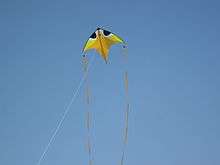
Many melas or fairs are held on Makar Sankranti the most famous being the Kumbha Mela, held every 12 years at one of four holy locations, namely Haridwar, Prayag (Prayagraj), Ujjain and Nashik. The Magha Mela (or mini-Kumbh Mela held annually at Prayag) and the Gangasagar Mela (held at the head of the Ganges River, where it flows into the Bay of Bengal). Makar Mela in Odisha. Tusu Mela also called as Tusu Porab is celebrated in many parts of Jharkhand and West Bengal. Poush Mela is an annual fair and festival that takes place in Santiniketan, in Birbhum District of West Bengal. Mela Maghi is held in memory of the forty Sikh martyrs (Chalis Mukte) who gave their lives to protect Guru Gobind Singh, the tenth Guru of Sikhism, every year at Muktsar Sahib in Punjab. Before this tradition, the festival was observed and mentioned by Guru Amar Das, the third Guru of Sikhism.[25]
Karnataka
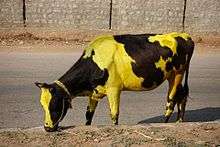
This is the Suggi (ಸುಗ್ಗಿ) or harvest festival for farmers of Karnataka. On this auspicious day, girls wear new clothes to visit near and dear ones with a Sankranti offering in a plate and exchange the same with other families. This ritual is called "Ellu Birodhu." Here the plate would normally contain "Ellu" (white sesame seeds) mixed with fried groundnuts, neatly cut dry coconut and fine cut bella (jaggery). The mixture is called "Ellu-Bella" (ಎಳ್ಳು ಬೆಲ್ಲ). The plate contains shaped sugar candy moulds (Sakkare Acchu, ಸಕ್ಕರೆ ಅಚ್ಚು) with a piece of sugarcane. There is a saying in Kannada "ellu bella thindu olle maathadi" that translates to 'eat the mixture of sesame seeds and jaggery and speak only good.' This festival signifies the harvest of the season, since sugarcane is predominant in these parts. Ellu Bella, Ellu Unde, bananas, sugarcane, red berries, haldi and kumkum and small gift items useful in everyday lives are often exchanged among women in Karnataka.

In some parts of Karnataka, a newly married woman is required to give away bananas for five years to married women (muthaidhe/sumangali) from the first year of her marriage and increase the number of bananas in multiples of five. There is also a tradition of some households giving away red berries "Yalchi Kai" with the above. In north Karnataka, kite flying with community members is a tradition. Drawing rangoli in groups is another popular event among women during Sankranti.
An important ritual is display of cows and bulls in colourful costumes in an open field. Cows are decorated for the occasion and taken on a procession. They are also made to cross a fire. This ritual is common in rural Karnataka and is called "Kichchu Haayisuvudu." It is celebrated on 14 or 15 January.
Andhra Pradesh and Telangana
The festival Sankranti is celebrated for four days in Andhra Pradesh[26] and Telangana:
- Day 1 – Bhogi (Andhra Pradesh, Telangana, Karnataka, Tamil Nadu and Maharashtra)
- Day 2 – Makara Sankranti, the main festival day
- Day 3 – Kanuma (Andhra Pradesh and Telangana)
- Day 4 – Mukkanuma (Andhra Pradesh and Telangana)
- Bhogi
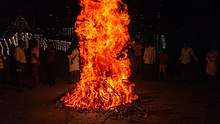
The day preceding Makara Sankranti is called Bhogi. This is when people discard old and derelict things and concentrate on new things causing change or transformation. At dawn, people light a bonfire[23] with logs of wood, other solid fuels and wooden furniture that are no longer useful.
- Makara Sankranti

The second day is Makara Sankranti. People wear new clothes, pray to God, and make offerings of traditional food to ancestors who have died. They also make beautiful and ornate drawings and patterns on the ground with chalk or flour, called rangoli or muggu in Telugu, in front of their homes. These drawings are decorated with flowers, colours and small, hand-pressed piles of cow dung, called gobbemma.
For this festival all families prepare chekkalu, chakralu, arisalu, buralu, gavvalu, purnalu, bundi mithai, bundi laddu, garelu, chakinalu, nuvvula appalu, katte appalu or karam appalu, madugulu (jantikalu), bellam appalu, kudumulu, ariselu, appalu (a sweet made of jaggery and rice flour), dappalam (a dish made with pumpkin and other vegetables) and make an offering to God.
- Kanuma
On the third day, Kanuma is celebrated. Kanuma is very intimate to the hearts of farmers because it is the day for praying and showcasing their cattle with honor. Cattle are the symbolic indication of prosperity. On the day after Makara Sankranti, the animal kingdom is remembered and, in particular, cows. Girls feed the animals, birds and fish as a symbol of sharing.
- Mukkanuma
The fourth day is called Mukkanuma which is popular among the non-vegetarians of the society. On this day, farmers offer prayers to the elements (like soil, rain, fire for helping the harvest) and the (village) goddesses with their gifts which sometimes (and these days mainly) include animals. Kanuma, Mukkanuma and the day following Mukkanuma call for celebrations with union of families, friends, relatives. People play with kites and the sky is filled with beautiful kites.
Another notable feature of the festival in Andhra Pradesh and Telangana is the Haridasu and Gangiredduvallu who go early in the morning with a colourfully decorated cow. Haridasus sing songs of Lord Vishnu (Hari); hence the name Haridasu (servant of Hari). It is a custom that he should not talk to anyone and only sing songs of Lord Vishnu when he goes to everyone's house.
Maharashtra

In Maharashtra on Makar Sankranti (मकर संक्रान्ति) day people exchange multicoloured halwa (sugar granules coated in sugar syrup) and til-gul laadoo (sweetmeats made from sesame seeds and jaggery). Gulachi poli/puran poli (गुळाची पोळी / पुरण पोळी) (flat bread stuffed with soft/shredded jaggery mixed with toasted, ground til [white sesame seeds]) and some gram flour, which has been toasted to golden in pure ghee, are offered for lunch. While exchanging til-gul as tokens of goodwill people greet each other with the words "तिळगुळ घ्या, आणि गोड-गोड बोला / til-gul ghyaa, aani goad-goad bolaa" meaning ‘Accept this til-gul (sweet) and utter sweet words’. The underlying thought in the exchange of til-gul is to forget the past ill-feelings and hostilities and resolve to speak sweetly and remain friends.
Married women invite friends/family members and celebrate Haldi-Kunku. Guests are given til-gul and some small gift, as a part of the ritual. Women make it a point to wear black clothes. As Sakranti falls in the winter months of the region, wearing black adds to the body warmth. This is an essential reason behind wearing black, which is otherwise barred on festival days. As per another legend, Lord Surya forgave his son Shani and his son visited him on Sankranti. And that's why people distribute everyone sweets and urge them to let go of any negative or angry feelings. While distributing sweets famous line “til gul ghya aani god god bola” (which means eat this sesame and jaggery and speak sweet words) is used in Maharashtra.
Assam
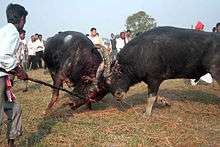
Magh Bihu (মাঘ বিহু) (also called Bhogali Bihu (ভোগালী বিহু) (Bihu of eating foods and enjoyment) or Maghar Domahi (মাঘৰ দোমাহী) is a harvest festival celebrated in Assam, India, which marks the end of harvesting season in the month of Maagha (January–February).[27] It is the Assam celebration of Makar Sankranti, with feasting lasting for a week.[28]
The festival is marked by feasts and bonfires.[29] Young people erect makeshift huts, known as Meji and Bhelaghar, from bamboo, leaves and thatch, and in Bhelaghar they eat the food prepared for the feast, and then burn the huts the next morning.[30] The celebrations also feature traditional Assamese games such as tekeli bhonga (pot-breaking) and buffalo fighting.[31] Magh Bihu celebrations start on the last day of the previous month, the month of "Pooh", usually the 29th of Pooh and usually the 14th of January, and is the only day of Magh Bihu in modern times (earlier, the festival would last for the whole month of Magh, and so the name Magh Bihu).[32] The night before is "Uruka" (28th of Pooh), when people gather around a bonfire, cook dinner, and make merry.
During Magh Bihu people of Assam make cakes of rice with various names such as Shunga Pitha, Til Pitha etc. and some other sweets of coconut called Laru or Laskara.
Bihar and Jharkhand
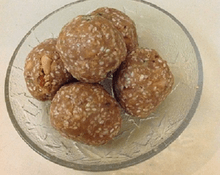
In Bihar and Jharkhand, the festival is celebrated on 14–15 January.
On 14 January, it is celebrated as Makar Sankranti or Til Sankrant or Sankrant or Khichdi (in local dialects). As in other parts of country, people take baths in rivers and ponds and feast upon seasonal delicacies as a celebration of good harvest. The delicacies include chura (flattened rice), dahi(curd), gur (jaggery), sweets made of til (sesame seeds) such as tilkut, tilgul, tilwa, maska, etc., milk, seasonal fruits and vegetables. Kite flying festivals are organised, albeit on a small scale.
On 15 January, it is celebrated as Makraat (in some parts of the state) when people relish special khichdi (dal-rice replete with cauliflower, peas and potatoes).
The festival is one of the most important. People start their day by worshiping and putting til (sesame seeds) into fire followed by eating "dahi-chuda", a dish made of beaten rice (chuda or poha, in Hindi, or avalakki, in Kannada) served with a larger serving of dahi (curd), with cooked kohada (red pumpkin) that is prepared specially with sugar and salt but no water. The meal is generally accompanied by tilkut and lai (laddu made of til, chuda and rice). The festive meal is traditionally made by women in groups. Since the meal is heavy, lunch is generally skipped on the day and the time is, instead, spent on socializing and participating in kite flying festivals.
At night a special khichdi is made and served with its four traditional companions, "char yaar" (four friends) – chokha (roasted vegetable especially mashed potato or brinjal), papad, ghee and achaar. Since such a rich khichdi is generally made on this festival, the festival is often colloquially referred to as "Khichdi".
Goa
Known as Sankrant in Goa and like in the rest of the country, people distribute sweets in the form of granules of sugar-coated till pulses among family members and friends, with the words,Till gull gheiat, godd uloiat, meaning Eat seasame and jaggery and sweeten your talk.
12-day Haldi Kumkum festival begins on Makar Sankranti, married women celebrate the festival till Ratha Saptami. Married women visit each other's homes where the women apply Halad(turmeric) and Kumkum (vermilion) to the foreheads of other women and put flowers in their hair, and offer them household gifts. Newly married women offer five sunghat or small clay pots with black beaded threads tied around them, to the deity. These pots are filled with newly harvested food grains and are offered with betel leaves and areca nut.[33] Its observance takes place on a rather subdued note, unlike major festivals of the region like Ganesh chaturthi.
Gujarat
Uttarayan, as Makar Sankranti is called in Gujarati, is a major festival in the state of Gujarat[34] which lasts for two days.
- 14 January is Uttarayan
- 15 January is Vasi-Uttarayan (Stale Uttarayan).[35]
Gujarati people keenly await this festival to fly kites, called 'patang'. Kites for Uttarayan are made of special light-weight paper and bamboo and are mostly rhombus shaped with central spine and a single bow. The string often contains abrasives to cut down other people's kites.
In Gujarat, from December through to Makar Sankranti, people start enjoying Uttarayan. Undhiyu (spicy, baked mix of winter vegetables) and chikkis (made from til (sesame seeds), peanuts and jaggery) are the special festival recipes savoured on this day. The Hindu Sindhi community in western regions of India, that is also found in southeastern parts of Pakistan, celebrate Makar Sankranti as Tirmoori. On this day, parents sending sweet dishes to their daughters.[36]
In the major cities of Ahmedabad, Surat, Vadodara, Rajkot, and Jamnagar the skies appear filled with thousands upon thousands of kites as people enjoy two full days of Uttarayan on their terraces.
When people cut any kites they yell words like "kaypo chhe", "e lapet","jaay jaay","phirki vet phirki" and "lapet lapet" in Gujarati.
Haryana and Delhi
"Sakraant" in Haryana and Delhi rural areas, is celebrated with traditional Hindu rituals of North India similar to Western UP and border areas of Rajasthan and Punjab. This includes ritual purification by taking the holy dip in rivers, especially in Yamuna, or at sacred ponds such as ancient sarovars Kurukshetra and at local tirtha ponds associated with the ancestral guardian/founder deity of the village called Jathera or Dhok (dahak in Sanskrit or fire) in villages to wash away sins. People prepare kheer, churma, halva with desi ghee and distribute til-gud (sesame and jaggery) laddoos or chikkis. Brothers of married woman visits her home with a gift pack, called "Sindhara" or "Sidha", of wood and warm clothing for her and her husband's family. Women give gift to their in-laws called "Manana". Women conggregate in the nearby havelis to sing Haryani folk songs and exchange gifts.[37]
Himachal Pradesh
In Shimla District of Himachal Pradesh, Makar Sankranti is known as Magha Saaji. Saaji is the Pahari word for Sakranti, start of the new month. Hence this day marks the start of the month of Magha.
According to Hindu religious texts, on the day of Uttarayani the sun enters the zodiac sign of Makara (Capricorn), i.e., from this day onwards the sun becomes 'Uttarayan' or it starts moving to the north. It is said that from this day, which signals a change of season, the migratory birds start returning to the hills. On Magha Saaja people wake up early in the morning and take ceremonial dips and shower in the springs or baolis. In the daytime people visit their neighbours and together enjoy khichdi with ghee and chaas and give it in charity at temples. Festival culminates with singing and Naati (folk dance).
Kerala
Makar Sankranti is celebrated in Kerala at Sabarimala where the Makara Jyothi is visible followed by the Makaravilakku celebrations.
Odisha
The festival is known as Makara Sankranti in Odisha[38] where people prepare makara chaula (Odia: ମକର ଚାଉଳ): uncooked newly harvested rice, banana, coconut, jaggery, sesame, rasagola, Khai/Liaa and chhena puddings for naivedya to gods and goddesses. The withdrawing winter entails a change in food habits and intake of nourishing and rich food. Therefore, this festival holds traditional cultural significance. It is astronomically important for devotees who worship the sun god at the great Konark temple with fervour and enthusiasm as the sun starts its annual swing northwards.[39] According to various Indian calendars, the Sun's movement changes and the days from this day onwards become lengthier and warmer and so the Sun-God is worshiped on this day as a great benefactor. Many individuals at the start of the day perform a ritual bath while fasting.[39] Makara Mela (Fun fair) is observed at Dhabaleswar in Cuttack, Hatakeshwar at Atri in Khordha, Makara Muni temple in Balasore and near deities in each district of Odisha. In Puri special rituals are carried out at the temple of Lord Jagannath.[39] In Mayurbhanj, Keonjhar, Kalahandi, Koraput and Sundargarh where the tribal population is greater, the festival is celebrated with great joy. They celebrate this festival with great enthusiasm, singing, dancing and generally having an enjoyable time. This Makara Sankranti celebration is next to the Odia traditional new year Maha Vishuva Sankranti which falls in mid April. Tribal groups celebrate with traditional dancing, eating their particular dishes sitting together, and by lighting bonfires.
It is the only Indian festival celebrated on a fixed day of the Gregorian calendar. Besides the usual rituals, people of Orissa, especially Western and Southern Orissa, reaffirm the strength of the bond of friendship with their best friends during this occasion. The practice is called ‘Makara Basma’or 'Makara Basiba'. After a man binds himself with one of his friends in the shackles of friendship during Makar Sankranti, afterwards he addresses the other as ‘Maharshad’ or ‘Marsad’; if two women tie the friendship lace on each other's wrist, they call each other ‘Makara’. They don't utter each other's name. This goes on for one full year till the next Makar Sankranti. In Eastern Orissa, on many occasions, two friends feed each other ‘Mahaprasad’, the offering made in the famous Jagannath temple of Puri, and continue the friendship for at least one year. Orissa Post talks to some women about their experiences when they tied the friendship knot on Makar Sankranti.
Punjab

In Punjab, Makar Sankranti is celebrated as Maghi which is a religious and cultural festival. Bathing in a river in the early hours on Maghi is important. Hindus light lamps with sesame oil as this is supposed to give prosperity and drive away all sins. A major mela is held at Sri Muktsar Sahib on Maghi which commemorates a historical event in Sikh history.
Culturally, people dance their famous "bhangra". They then sit down and eat the sumptuous food that is specially prepared for the occasion. It is traditional to eat "kheer", rice cooked in milk and sugarcane juice. It is also traditional to consume khichdi and jaggery. December and January are the coldest months of the year in the Punjab. Maghi represents the change of the season to warmer temperatures and increase in daylight. Maghi fairs are held in many places.
Rajasthan and Western Madhya Pradesh (Malwa & Nimar)
"Makar Sankrati" or "Sakraat" in the Rajasthani language[40] is one of the major festivals in the state of Rajasthan. The day is celebrated with special Rajasthani delicacies and sweets such as pheeni (either with sweet milk or sugar syrup dipped), til-paati, gajak, kheer, ghevar, pakodi, puwa, and til-laddoo.[41]
Specially, the women of this region observe a ritual in which they give any type of object (related to household, make-up or food) to 13 married women. The first Sankranti experienced by a married woman is of significance as she is invited by her parents and brothers to their houses with her husband for a big feast. People invite friends and relatives (specially their sisters and daughters) to their home for special festival meals (called as "Sankrant Bhoj"). People give out many kind of small gifts such as til-gud (jaggery), fruits, dry khichadi, etc. to Brahmins or the needy ones.
Kite flying is traditionally observed as a part of this festival.[42] On this occasion the sky in Jaipur and Hadoti regions is filled with kites, and youngsters engage in contests trying to cut each other's strings.[42]
Tamil Nadu
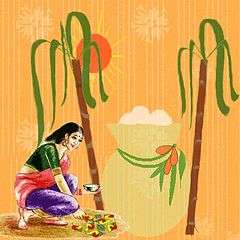
It is a four-day festival in Tamil Nadu:
- Day 1: Bhogi Pandigai (போகி பண்டிகை)
- Day 2: Thai Pongal (தை பொங்கல்)
- Day 3: Maattu Pongal (மாட்டுப் பொங்கல்)
- Day 4: Kaanum Pongal (காணும் பொங்கல்)
The festival is celebrated four days from the last day of the Tamil month Margazhi to the third day of the Tamil month Thai.
- Bhogi
The first day of festival is Bhogi (போகி). It is celebrated on the last day of Margazhi[43] by throwing away and destroying old clothes and materials, by setting them on fire, marking the end of the old and the emergence of the new. In villages there will be a simple ceremony of "Kappu Kattu" (kappu means secure). The 'neem' leaves are kept along the walls and roof of the houses. This is to eliminate evil forces.
- Thai Pongal
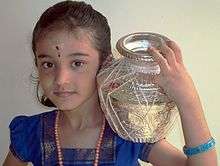
The second day of festival is Thai Pongal or simply Pongal. It is the main day of the festival, falling on the first day of the Tamil month Thai which starts with the solar cycle when sun starts moving towards the summer solstice (uttarayana). It is celebrated by boiling rice with fresh milk and jaggery in new pots, which are later topped with brown sugar, cashew nuts and raisins early in the morning and allowing it to boil over the vessel. This tradition gives Pongal its name. The moment the rice boils over and bubbles out of the vessel, the tradition is to shout "பொங்கலோ பொங்கல் (Ponggalo Ponggal)!" and blow the sangu (a conch), a custom practised to announce it was going to be a year blessed with good tidings. Then, new boiled rice is offered to the Sun god during sunrise, as a prayer which symbolises thanks to the sun for providing prosperity. It is later served to the people in the house for the ceremony. People prepare savouries and sweets such as vadai, murukku, payasam and visit each other and exchange greetings.
- Maattu Pongal
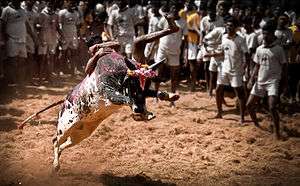
The third day of festival is Maattu Pongal (மாட்டுப் பொங்கல்). It is for offering thanks to cattle, as they help farmers in agriculture. On this day the cattle are decorated with paint, flowers and bells. They are allowed to roam free and fed sweet rice and sugar cane. Some people decorate the horns with gold or other metallic covers. In some places, Jallikattu, or taming the wild bull contest, is the main event of this day and this is mostly seen in the villages.
- Kaanum Pongal
The fourth day of the festival is Kaanum Pongal (காணும் பொங்கல்: the word kaanum means "to view"). During this day people visit their relatives, friends to enjoy the festive season. It is a day to thank relatives and friends for their support in the harvest. It started as a farmers festival, called as Uzhavar Thirunaal in Tamil. Kolam (கோலம்) decorations are made in front of the house during Thai Pongal festival.
Uttar Pradesh
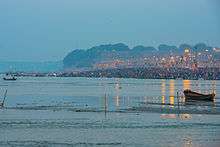
The festival is known as Kicheri in Uttar Pradesh and involves ritual bathing.[44] Over two million people gather at their respective sacred places for this holy bathing such as Allahabad and Varanasi in Uttar Pradesh and Haridwar in Uttarakhand.[45] If they cannot go in river then they bathe at home. There is a compulsion to bathe in the morning while fasting; first they bathe then they eat sweets such as til ladoo and gud laddo (known as tillava in Bhojpuri). At some places new clothes are worn on this day.
Kite flying is an inevitable part of the festival in Uttar Pradesh,[45] as with many states of India such as Gujarat and Maharashtra. Like other places in India, the references to sweets, til (sesame seeds) and gud (jaggery) are found in the songs sung on this day:
Meethe Gur me mil gaya Til,
Udi Patang aur khil gaye Dil,
Jeevan me bani rahe Sukh aur Shanti,
Mubarak ho aapko Makar-Sankranti.
Uttarakhand
Makar Sankranti is a popular festival in Uttarakhand. It known by various names in the different parts of the state such as Uttarayani, Khichri Sangrand, Pusyodia, Ghughutia, Ghughuti Tyar, Kale Kauva, Makrain, Makraini, Gholda, Gwalda and Chunyatyar.[46]
It is believed that on this day, Surya Deota (Hindu Solar God) enters into 'Makara Rashi' (Capricorn zodiac) from 'Dhanu Rashi' (Sagittarius zodiac) as per the Hindu calendar. It is also believed that this is the first day of the period of Uttarayana (Sidereal Uttarayana) as per Hindu astrology when the Sun starts moving into the Northern hemisphere after completing six months in the Southern hemisphere. From this day onwards, as the sun moves from the Winter solstice towards the Summer solstice, the days start getting longer. It is said that from the day of Makar Sankranti, which signals a change of season, migratory birds start returning to the hills of Uttarakhand from the plains of India where they migrate during the winters to escape the extreme cold and snowfall in the hills.
In the Kumaon region of Uttarakhand, Makar Sankranti (also called as Ghughuti (घुघुति) or Ghughuti Tyar or Ghughutia or Kale Kauva or Uttarayani) is celebrated with great gusto. The famous Uttarayani mela (fair) is held in Bageshwar town each year in the month of January on the occasion of Makar Sankrati.[47][48] According to the Almora Gazetteer, even in the early twentieth century, the annual Uttarayani mela at Bageshwar was visited by approximately 15,000 people and was the largest fair of Kumaon division.[49] The religious ritual of the Uttarayani mela consists of bathing before daybreak at the confluence of Saryu and Gomati followed by an offering of water to Lord Shiva inside the Bagnath Temple.[50][51] Those who are more religiously disposed, continue this practice for three days in succession, which is known as "Trimaghi".[50] On this day, people also give 'khichdi' (a dish made by mixing pulses and rice) in charity, take ceremonial dips in holy rivers, participate in Uttarayani fairs and celebrate the festival of Ghughutia or Kale Kauva. During the festival of Kale Kauva (literal translation 'black crow') people make 'Ghughute', deep fried sweetmeats consisting of flour and jaggery, made in attractive shapes such as drums, pomegranates, knives, and swords.These ghughute are then fed to crows and other birds by the children on the morning of Makar Sankranti. Children while adorning necklaces made of the ghughute chant songs like[52]
काले कव्वे काले, घुगुती माला खा ले |
O black crow, come eat this garland made out of ghughute
काले कव्वे आ, लगड़ बड़ा खा |
O black crow come, eat ‘lagad‘ (poori the puffed Indian flat bread)’ and ‘badaa‘ (Urad daal i.e. Lentils balls deep fried in oil)…
काले कौवा का का, पुसे रोटी माघै खा|
O black crow come, eat ‘Paush‘ month (January) ‘Roti‘ (flat bread) in ‘Maagh‘ (February).
ले कव्वा बड़ो, मैं कें दे सुनाक घड़ो |
Here crow, come take this lentil ball & give me a gold pitcher (blessings)…
ले कव्वा ढाल, मैं कें दे सुनाक थाल |
Here crow, come take this shield (made of kneaded flour) & give me a gold plate (blessings)…
ले कव्वा तलवार, मैं कें दे ठुलो घरबार |
Here crow, come take this sword (made of kneaded flour) & give me prosperity (blessings)…
There are numerous legends associated with the practice of offering sweetmeats to crows and other birds during Makar Sankranti. Legend has it that Raja Kaylan Singh, a king from the ancient Chand Dynasty of Kumaon was childless and to remedy this situation, the hapless king and queen sought the blessings of Lord Shiva at the Baghnath Temple in Kumaon. Soon after, the royal couple was blessed with a child who was named Raja Nirbhaya Singh, affectionately called 'Ghughutiya'. The child prince wore a pearl necklace that he was very fond of and it is said that the 'Ghughute' sweetmeat garlands are worn by children on the day of Makar Sankranti in fond memory of this child prince of Kumaon. Another legend has it that a certain king of Kumaon had a minister called 'Ghughutiya' who once conspired to kill him. Much to the king's good fortune, a kindly crow warned him about Ghughutiya's evil intentions, thus granting the king the boon of life. It is said that the practice of making offerings of sweetmeats to crows started from this day in Kumaon. Alternately, many people believe that the offerings to the crows are made to pay homage to the departed souls of their ancestors.[52]
West Bengal
In West Bengal, Sankranti, also known as Poush Sankranti[53] named after the Bengali month in which it falls (last date of that month), is celebrated as a harvest festival Poush Parbon (Bengali: পৌষ পার্বণ). (It falls on 14 January on the Western calendar.) The freshly harvested paddy and the date palm syrup in the form of Khejurer Gur (Bengali: খেজুরের গুড়)and Patali (Bengali: পাটালি ) is used in the preparation of a variety of traditional Bengali sweets made with rice flour, coconut, milk and 'khejurer gur' (date palm jaggery) and known as 'Pitha' (Bengali: পিঠে). All sections of society participate in a three-day festival that begins on the day before Sankranti and ends on the day after. The Goddess Lakshmi is usually worshipped on the day of Sankranti.
In the Himalayan regions of Darjeeling, the festival is as known as Magey Sakrati. It is distinctly associated with the worship of Lord Shiva. Traditionally, people bathe at sunrise and then commence their pooja. Elsewhere, many people take a dip in places like Ganga Sagar (the point where the river Ganges meets the Bay of Bengal).[54] Ganga Sagar falls in West Bengal.
In the day of Makar Sankranti Hindu God Dharma is worshiped. And khichurhi or rice is offered to the God as Bhog (ভোগ). The day after Makar Sankranti the first day in the month Magh from Bengali calendar The Goddess Laxmi devi is worshiped. It is called Baharlaxmi Puja as the idol is worshiped in an open place.
Outside India
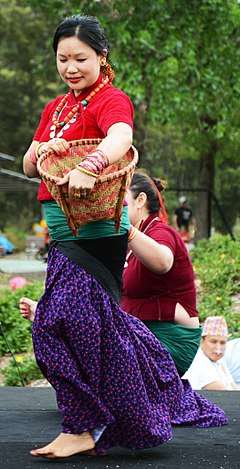
Bangladesh
Shakrain is an annual celebration of winter in Bangladesh, observed with the flying of kites.[55]
Nepal
Maghe Sankranti (Nepali:माघे सङ्क्रान्ति, Mathili:माघि, Nepal Bhasa:घ्यःचाकु संल्हु) is a Nepalese festival observed on the first of Magh in the Vikram Sambat (B.S) calendar (about 14 January) bringing an end to the winter solstice containing month of Poush. Tharu people celebrate this particular day as new year. It is also regarded as the major government declared annual festival of the Magar community. Maghe Sankranti is similar to solstice festivals in other religious traditions.
Observant Hindus take ritual baths during this festival. These include Sankhamul on the Bagmati near Patan; In the Gandaki/Narayani river basin at Triveni, Devghat near Chitwan Valley and Ridi on the Kaligandaki; and in the Koshi River basin at Dolalghat on the Sun Koshi. Festive foods like laddoo, ghee and sweet potatoes are distributed. The mother of each household wishes good health to all family members.
Date and significance
Generally makar sankranti falls on 14 January, and is called Makar Sankranti or other names in the Indian subcontinent. Maghe Sankranti is a major harvest festival celebrated in Madhesh and Tharuhat of Nepal. The movement of the sun from one zodiac sign into another is called Sankranti and as the Sun moves into the Capricorn zodiacal sign known as Makara, this occasion is named as Makara Sankranti in the Pahari context. It is one of the few Nepalese festivals of Madhesi and Tharu people celebrate it on a fixed date, i.e., 14 January because this solar festival in the honor of deity Surya follows the solar cycle of the Bikrami calendar, unlike other festivals that follow lunar cycle.
Maghe Sankranti is regarded as marking the beginning of an auspicious phase in Nepalese culture. It is cited as the 'holy phase of transition'. It marks the end of an inauspicious phase which according to the Hindu calendar begins around mid-December. It is believed that any auspicious and sacred ritual can be sanctified in any Nepali family, this day on-wards. Scientifically, this day marks the beginning of warmer and longer days compared to the nights. In other words, Sankranti marks the termination of winter season and beginning of a new harvest or spring season.
All over the country, Maghe Sankranti is observed with great fanfares. However, it is celebrated with distinct names and rituals in different parts of the country. In the states of northern and western Nepal, the festival is celebrated as the Makar Sankranti day with special zeal and fervour. The importance of this day has been signified in the ancient epics like Mahabharata. So, apart from socio-geographical importance, Maghe Sankranti holds historical and religious significance. As it is the festival of Sun God, and he is regarded as the symbol of divinity and wisdom, the festival holds an eternal meaning.
Makar Sankranti and the Winter Solstice
Many Nepalese conflate this festival with the Winter Solstice, and believe that the sun ends its southward journey (Sanskrit: Dakshinayana) at the Tropic of Capricorn, and starts moving northward (Sanskrit: Uttarayana) towards the Tropic of Cancer, in the month of Poush on this day in mid-January.
While there is no overt solar observance of Winter Solstice in the Nepali religion, the Vaikuntha Ekadashi festival, calculated on the lunar calendar, falls the closest. Further, the Sun makes its northward journey on the day after winter solstice when day light increases. Therefore, Makar Sankranti signifies the celebration of the day following the day of winter solstice.
Scientifically, currently in the Northern Hemisphere, winter solstice occurs between 21 and 22 December. Day light will begin to increase on 22 December and on this day, the Sun will begin its northward journey which marks Uttarayaan. The date of winter solstice changes gradually due to the Axial precession of the Earth, coming earlier by approximately 1 day in every 70 years. Hence, if the Maghe Sankranti at some point of time did mark the day after the actual date of winter solstice, a date in mid-January would correspond to around 300 CE.
Pakistan (Sindh)
On this festive day, Sindhi parents send ladoos and chiki (Laaee) made of sesame seeds to their married daughters. The Sindhi community in India too celebrate Makar Sankranti as Tirmoori which involves parents sending sweet dishes to their daughters.[56]
Sri Lanka
On this day, the Sri Lanka Tamil farmers honor the Sun God Suriyapakaran. This happens when the sun enters the zodiac sign of Capricorn (Makara). The Thai Pongal festival is celebrated in mid-January, or the Tamil month of Thai, to coincide with the rice harvest.[57]
See also
- Hindu festivals
- Uttarayana
- Jallikattu
- List of Harvest Festivals
References
- https://www.india.gov.in/calendar?date=2019-01
- https://www.india.gov.in/calendar?date=2020-01
- Kamal Kumar Tumuluru (2015). Hindu Prayers, Gods and Festivals. Partridge. p. 30. ISBN 978-1-4828-4707-9.
- J. Gordon Melton (2011). Religious Celebrations: An Encyclopedia of Holidays, Festivals, Solemn Observances, and Spiritual Commemorations. ABC-CLIO. pp. 547–548. ISBN 978-1-59884-205-0., Quote: "Makara Sankranti (January 14); Makara Sankranti is a festival held across India, under a variety of names, to honor the god of the sun, Surya."
- Henderson, Helene (2005). Holidays, festivals, and celebrations of the world dictionary Third edition. Electronic edition: Detroit: Omnigraphics. p. xxix. ISBN 0-7808-0982-3.
- James G. Lochtefeld (2002). The Illustrated Encyclopedia of Hinduism: A–M. Rosen Publishing Group. p. 411. ISBN 978-0-8239-2287-1.
- "Makar Sankranti 2019: क्यों मनाई जाती है मकर संक्रांति, महत्व, पूजा विधि और मंत्र". PujaBooking. Retrieved 13 January 2019.
- Jain Chanchreek; K.L. Chanchreek; M.K. Jain (2007). Encyclopaedia of Great Festivals. Shree Publishers. pp. 36–38. ISBN 978-81-8329-191-0.
- "After a 100 years, Makar Sankranti gets a new date", The Hindustan Times (Jan 14, 2017)
- Nikita Desai (2010). A Different Freedom: Kite Flying in Western India; Culture and Tradition. Cambridge Scholars Publishing. pp. 30–33. ISBN 978-1-4438-2310-4.
- Kailash Puri; Eleanor Nesbitt (2013). Pool of Life: The Autobiography of a Panjabi Agony Aunt. Sussex Academic Press. pp. 34–35. ISBN 978-1-78284-067-1.
- Kapila Vatsyayan (1987). Traditions of Indian folk dance. Clarion Books. pp. 192–193. ISBN 978-0-85655-253-3.
- Diana L. Eck (2013). India: A Sacred Geography. Random House. pp. 152–154. ISBN 978-0-385-53192-4.
- "Kumbha Mela: The Largest Gathering on Earth", Alan Taylor, The Atlantic (January 14, 2013)
- Biggest Gathering On Earth' Begins In India; Kumbha Mela May Draw 100 Million, Mark Memmott, NPR, Washington DC (January 14, 2013)
- Roshan Dalal (2011), The Religions of India: A Concise Guide to Nine Major Faiths, Penguin, ISBN 978-0-14-341517-6, see Kumbh Mela entry
- Bhavana Nair (1989). Our Leaders. Orient Longman. p. 65. ISBN 978-81-7011-678-3., Quote: "One was at the famous Bageshwar fair held on Makar Sankranti day on the banks of Sarayu on January 15, 1921.";
M. Chalapathi Rau (1981). Govind Ballabh Pant, his life and times. Allied. p. 40. - Karen Bellenir (1998). Religious Holidays and Calendars: An Encyclopedic Handbook. Omnigraphics. pp. 140–142. ISBN 978-0-7808-0258-2.
- Robert Sewell; Śaṅkara Bālakr̥shṇa Dīkshita (1896). The Indian Calendar: With Tables for the Conversion of Hindu and Muhammadan Into A.D. Dates, and Vice Versa. S. Sonnenschein & Company. pp. 9–12, 26–31.
- MN Saha and NC Lahiri (1992), History of the Calendar, CSIR, pp. 259–260
- KD Abbhyankar (1999). Astrophysics of the Solar System. Universities Press, Orient Longman. pp. 246–247. ISBN 978-81-7371-124-4.
- Beteille, Andre (1964). "A Note on the Pongal Festival in a Tanjore Village". Man. 64: 73–75, see discussion of Makar Sankranti. doi:10.2307/2797924. JSTOR 2797924.
- Tumuluru, Kamal Kumar (2015 hi me rpota), Hindu Prayers, Gods and Festivals, Partridge Publishing
- LLP, Adarsh Mobile Applications. "Makar Sankranti | Makara Sankranti". www.drikpanchang.com. Retrieved 15 January 2020.
- Jawandha, Major Nahar Singh (1 January 2010). Glimpses of Sikhism. Sanbun Publishers.
- Rajat Gupta, Nishant Singh, Ishita Kirar & Mahesh Kumar Bairwa (2015) Hospitality & Tourism Management. Vikas Publishing House
- "Celebrating Nature's Bounty – Magh Bihu". EF News International. Archived from the original on 17 January 2012. Retrieved 14 January 2012.
- Sharma, S. P.; Seema Gupta (2006). Fairs & Festivals Of India. Pustak Mahal. p. 25. ISBN 978-81-223-0951-5.
- The New Encyclopædia Britannica. 21. Encyclopaedia Britannica. 1987. p. 137. ISBN 978-0-85229-571-7.
- "Bihu being celebrated with joy across Assam". The Hindu. 14 January 2005. Retrieved 2 May 2009.
- "Bonfire, feast & lots more – Jorhat celebrations promise traditional joy this Magh Bihu". The Telegraph. 12 January 2008. Archived from the original on 15 June 2009. Retrieved 2 May 2009.
- "Assamese calendar".
- "Of sesame laddoos and prayers for husbands - Times of India". The Times of India.
- Desai, Anjali H. (2007) India Guide Gujarat. India Guide Publications
- Vyas, Rajnee (16 January 2019). "Welcome to Gujarat". Akshara Prakashan – via Google Books.
- Reejhsinghani, Aroona (2004) Essential Sindhi Cookbook. Penguin Books India
- , News18, 10 Jan 2019.
- Goyal, Ashutosh (2014) RBS Visitors Guide India – Odisha: Odisha Travel Guide. Data and Expo India Pvt Ltd
- Times News Network (TNN) (15 January 2014). "Makar Sankranti observed with pomp in state". The Times of India. Archived from the original on 15 January 2014.
- Krishnan, Rukmini (10 January 2014). "Makar Sankranti Celebrations". DNA (Diligent Media Corporation). Archived from the original on 15 January 2014.
- "Makar Sankranti Food". Ifood TV. Archived from the original on 15 January 2014.
- Press Trust of India (PTI) (14 January 2014). "Makar Sankranti celebrations: Sky lanterns dot the sky". The Times of India.
- "Eastern World". 16 January 2019 – via Google Books.
- Bhalla, Kartar Singh (2005) Let's Know Festivals of India. Star Publications
- "Traditional fervour marks Makar Sankranti". The Times of India. 15 January 2012.
- "eUttaranchal - Rediscover Uttarakhand - Tourism, Culture & People". www.euttaranchal.com. Retrieved 18 January 2020.
- Singh, S.K.; Nag, P., eds. (1999). Tourism and trekking in Nainital Region. New Delhi: Concept Pub. ISBN 978-81-7022-769-4.
- "पतित पावनी सरयू-गोमती नदी का संगम गंदगी मुक्त हुआ". Amar Ujala Bureau (in Hindi). Bageshwar: Amar Ujala. 26 December 2016. Retrieved 24 May 2017.
- Walton, H. G. (1911). Almora: A Gazetter. Allahabad: The Government Press, United Provinces. pp. Appendix XXIV.
- Pant, Shiva Darshan. The Social Economy of the Himalayans: Based on a Survey in the Kumaon Himalayas. Mittal Publications. p. 197. Retrieved 15 October 2016.
- "Choliya dances enthrall at Bageshwar mela". Almora: Harsha S. TNN. 14 June 2016. Retrieved 15 December 2018.
- "Ghughuti 'The Mouth-Watering Festival of Kumaon', Ghughuti Festival". Uttarakhand Stories – Connect to Uttarakhand with eUttarakhand and Share Stories. 2 November 2016. Retrieved 15 January 2020.
- Bengal (India), West (16 January 1972). "West Bengal District Gazetteers: Calcutta and Howrah". State editor, West Bengal District Gazetteers – via Google Books.
- "Devotees throng Gangasagar on Makara Sankranti". Retrieved 15 January 2012.
- http://www.thedailystar.net/star-weekend/shakrain-festival-kites-and-fireworks-205195
- Reejhsinghani, Aroona (2004) Essential Sindhi Cookbook. Penguin Books India
- "Harvest Festival in Sri Lanka – Ulavar Thirunaal, Pongal Festival". www.pongalfestival.org.
External links
| Wikimedia Commons has media related to Makar Sankranti. |
| Wikiquote has quotations related to: Makar Sankranti |


